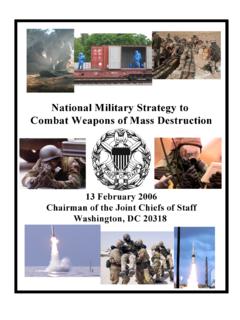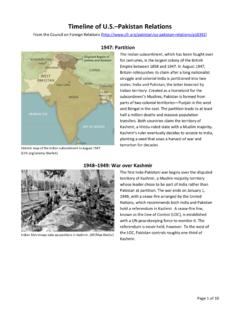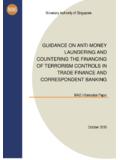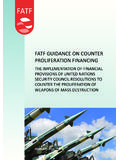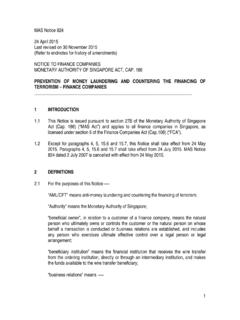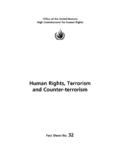Transcription of How Terrorist Groups End: Lessons for Countering …
1 This document and trademark(s) contained herein are protected by law as indicated in a notice appearing later in this work. This electronic representation of RAND intellectual property is provided for non-commercial use only. Unauthorized posting of RAND PDFs to a non-RAND Web site is prohibited. RAND PDFs are protected under copyright law. Permission is required from RAND to reproduce, or reuse in another form, any of our research documents for commercial use. For information on reprint and linking permissions.
2 Please see RAND Electronic Distribution RightsVisit RAND at the RAND CorporationView document detailsFor More InformationThis PDF document was made available from as a public service of the RAND down to documentTHE ARTSCHILD POLICYCIVIL JUSTICEEDUCATIONENERGY AND ENVIRONMENTHEALTH AND HEALTH CAREINTERNATIONAL AFFAIRSNATIONAL SECURITYPOPULATION AND AGINGPUBLIC SAFETYSCIENCE AND TECHNOLOGYSUBSTANCE ABUSETERRORISM AND HOMELAND SECURITYTRANSPORTATION ANDINFRASTRUCTUREWORKFORCE AND WORKPLACEThe RAND Corporation is a nonprofit research organization providing objective analysis and effective solutions that address the challenges facing the public and private sectors around the this documentBrowse Books & PublicationsMake a charitable contributionSupport RANDThis product is part of the RAND Corporation monograph series.
3 RAND monographs present major research findings that address the challenges facing the public and private sectors. All RAND mono-graphs undergo rigorous peer review to ensure high standards for research quality and Terrorist Groups END Lessons for Countering al Qa idaSETH G. JONES MARTIN C. LIBICKIThe R AND Corporation is a nonprofit research organization providing objective analysis and effective solutions that address the challenges facing the public and private sectors around the world.
4 R AND s publications do not necessarily reflect the opinions of its research clients and is a registered trademark. Copyright 2008 R AND CorporationAll rights reserved. No part of this book may be reproduced in any form by any electronic or mechanical means (including photocopying, recording, or information storage and retrieval) without permission in writing from R 2008 by the R AND Corporation1776 Main Street, Box 2138, Santa Monica, CA 90407-21381200 South Hayes Street, Arlington, VA 22202-50504570 Fifth Avenue, Suite 600, Pittsburgh, PA 15213-2665 RAND URL: order R AND documents or to obtain additional information, contact Distribution Services.
5 Telephone: (310) 451-7002; Fax: (310) 451-6915; Email: design by Carol EarnestThis research in the public interest was supported by R AND, using discretionary funds made possible by the generosity of R AND's donors, the fees earned on client-funded research, and independent research and development (IR&D) funds provided by the Department of of Congress Cataloging-in-Publication DataJones, Seth G., 1972 How Terrorist Groups end : Lessons for Countering Al Qa ida / Seth G. Jones, Martin C. Libicki.
6 P. cm. Includes bibliographical references. ISBN 978-0-8330-4465-5 (pbk. : alk. paper) 1. Terrorism. 2. Terrorism Prevention International cooperation. 3. Intelligence service. 4. Problem-oriented policing. 5. Qaida (Organization) I. Libicki, Martin C. II. Title. 2008 '16 dc222008025194xiiiSummaryAll Terrorist Groups eventually end. But how do they end? Answers to this question have enormous implications for counterterrorism efforts. The evidence since 1968 indicates that most Groups have ended because (1) they joined the political process or (2) local police and intelligence agencies arrested or killed key members.
7 Military force has rarely been the primary reason for the end of Terrorist Groups , and few Groups within this time frame achieved victory. This has significant implica-tions for dealing with al Qa ida and suggests fundamentally rethinking post September 11 counterterrorism ending of most Terrorist Groups requires a range of policy instruments, such as careful police and intelligence work, military force, political negotiations, and economic sanctions. Yet policy makers need to understand where to prioritize their efforts with limited resources and attention.
8 Following an examination of 648 Terrorist Groups that existed between 1968 and 2006, we found that a transition to the polit-ical process is the most common way in which Terrorist Groups ended (43 percent). The possibility of a political solution is inversely linked to the breadth of Terrorist goals. Most Terrorist Groups that end because of politics seek narrow policy goals. The narrower the goals of a terror-ist organization, the more likely it can achieve them without violent action and the more likely the government and Terrorist group may be able to reach a negotiated Terrorist Groups that cannot or will not make a transi-tion to nonviolence, policing is likely to be the most effective strategy (40 percent).
9 Police and intelligence services have better training and xiv How Terrorist Groups End: Lessons for Countering al Qa idainformation to penetrate and disrupt Terrorist organizations than do such institutions as the military. They are the primary arm of the gov-ernment focused on internal security matters. Local police and intel-ligence agencies usually have a permanent presence in cities, towns, and villages; a better understanding of the threat environment in these areas; and better human reasons are less common.
10 For example, in 10 percent of the cases, Terrorist Groups ended because their goals were achieved, and military force led to the end of Terrorist Groups in 7 percent of the cases. Militaries tended to be most effective when used against Terrorist Groups engaged in an insurgency in which the Groups were large, well armed, and well organized. Insurgent Groups have been among the most capable and lethal Terrorist Groups , and military force has usu-ally been a necessary component in such cases.


